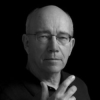Sam Abell

Sam Abell
Sam Abellis an American photographer known for his frequent publication of photographs in National Geographic. He first worked for National Geographic in 1967, and is one of the more overtly artistic photographers among his magazine peers. Sam Abell's style of photography is documentary in the sense that his major avenue, the National Geographic magazine, is a publication of record. However, his best work is known for its transcendent qualities, starting at the documentary level yet open to interpretation on an...
NationalityAmerican
ProfessionPhotographer
CountryUnited States of America
I had a book come out several years ago, when there were no blogs. This is a mark to me about how the environment has changed.
There are a lot of ways to talk about the life of a photograph. You can talk about the afterlife of a photograph, and in the end I talk about that, with the Richard Prince picture. But mainly, what I dedicated the book to being about was how photographs begin their life, and where they begin it. And they begin it with the photographer's imagination and instinct and experience.
I was giving a lecture and I said, that's enough about The Photographic Life, meaning my biography, now let's talk about the life of a photograph. And in that one instant I got the title for a potential next book.
The neatest part of this book I'm working on - to me - are the pictures that show the process... Because photographers... think things through and... it isn't luck, and it isn't random and it isn't accidental. It isn't.
There isn't an aspect of book creation I don't enjoy, and there has always been a book in my life to dream about or work on.
I think of myself as a writer who photographs. Images, for me, can be considered poems, short stories or essays. And I've always thought the best place for my photographs was inside books of my own creation.
That statement [ Stephen Ambrose:'You, Sam, have the hardest job, which is, pretend like nothing has happened in the last 200 years.'] woke me up to the fact that the landscape that Lewis and Clark came across was greater than the Serengeti. And it's gone.
Though Geographic didn't publish that photo in the story that it was done for, "The Life of Charlie Russell," a cowboy artist in Montana. But later, maybe a year and a half ago, they named it one of the 50 greatest pictures ever made at National Geographic.
That's who comes to my workshops. I jokingly tell my students that the class could be called "Your photographs: Better."
In the last workshop I taught, a woman flew in from Thailand. She's a medical doctor in Bangkok. I asked her in her one-on-one session where she wanted photography to be in her life.Did she want a second career? Was it about earning money? Or was it art? And she said "None of those. I want photography to be serious in my life." It would be like someone wanting music, like piano playing, to be a richer, deeper, and maybe even harder experience.
Increasingly, it's people not interested in National Geographic.
I was a consultant for Kodak back in the late 80's. There were engineers there who told me that in the future, most photographs would be taken on telephones. They weren't able to do anything with that. They were engineers, not management.
My Dad took a workshop from a photographer who worked at the Toledo Blade, a newspaper I delivered. I knew this photographer's work. My Dad took a night class from him at the University of Toledo. Without that class, I wouldn't have become a photographer, because my Dad came home and taught me what he learned in class.
The class that I teach is called "The Life of a Photograph." It takes up the question, of the billion photographs that were taken today, how many will have a life, and why? So the new reality has made the question more pertinent, not less pertinent.